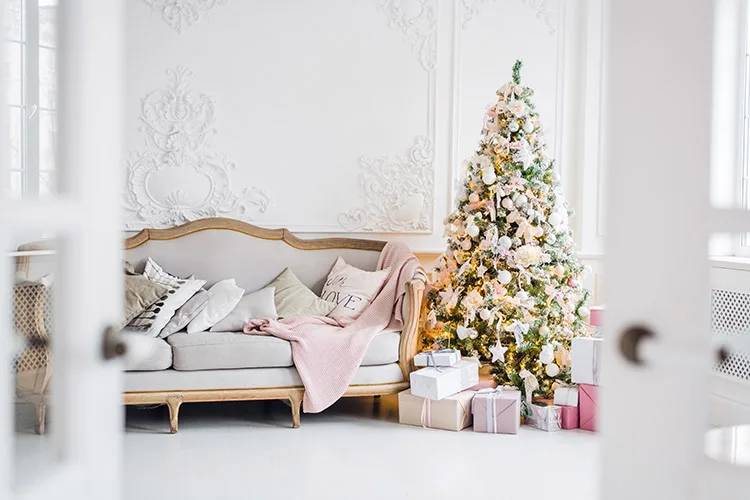As we slide closer to the holidays you might be thinking that you should either a) take your home off the market until after the new year or b) skip the decorating. Honestly, there’s no reason to do either. Why?
Well, first of all, leaving your home on the market during the holidays is a good thing. After all, your house can’t actually sell if it’s not available, can it? Secondly, your holiday decorations can have a positive influence on a potential buyer (a house that appeals to the senses and sparks feelings of nostalgia can go a long way). With that said, there’s a right and a wrong way to decorate for the holidays when your home is on the market. You can still celebrate the season–no matter what the holiday–but it’s important that you keep your home appealing to potential buyers.
1. Nix the excess clutter.
One of the most important things you can do when preparing your home for sale is to declutter and remove excess items. If your house is already full of furniture, knickknacks, toys and other possessions, piling on lots of decorative items can create a chaotic, overwhelming feel for potential buyers. Too much visual clutter distracts from the home itself and makes rooms feel smaller and darker. A good general rule when selling your house is that less is more. Give each room a thorough decluttering to pare down the sheer amount of stuff. Box up out-of-season clothes, donate unused kitchen gadgets, put away half of the throw pillows and knickknacks. Creating open, airy spaces helps buyers focus on the home’s best features and imagine themselves living there.
Staging your home isn’t about packing it with decorations and holiday baubles. Rather, the goal is to highlight the home’s assets by removing distractions. Clean every room thoroughly to get rid of dust and grime. Ensure windows are sparkling to let in natural light. Remove personal photos and mementos so buyers can picture their own lives. The overall effect you want to achieve is calm, orderly and spacious. Cluttered, jam-packed rooms feel stressful and chaotic. Even if you love your cozy, packed-full style, resist over-decorating when selling. Paint, lighting and furniture can add warmth and character. But let the home itself shine through by clearing away the excess. This helps buyers see past the clutter to the property’s potential as their future home.
2. Pay attention to proportions.
When decorating for the holidays, proportions matter. Oversized pieces can overwhelm and make rooms feel cluttered. For example, an enormous wreath on the front door or gigantic tree in the living room might seem celebratory, but in reality draws too much attention and makes spaces feel crowded.
Instead, opt for holiday decorations and accents that are appropriately scaled for each area of the home. Take measurements and evaluate the existing dimensions of the space. An entryway measuring just a few feet wide simply can’t accommodate a massive 8-foot wreath without it monopolizing the area. Similarly, a narrow living room will feel cramped with a tree whose base takes up half the floorspace.
Avoid holiday pieces that are too bulky or prominent for the allotted area. An American flag the size of a bedsheet will swallow up an entryway. Oversize wreaths flanking the front door call too much attention. When selecting seasonal accents, consider the room’s existing scale and decorate accordingly. The goal is for decorations to enhance, not detract from the home. Keep pieces tasteful and thoughtfully sized to fit each area. During the holidays, it’s fine to get festive. But steer clear of bold, brash décor that overtakes your home’s best attributes. With care and restraint, you can incorporate holiday cheer in ways that highlight, rather than overshadow, the value of your residence.
3. Appeal to their sense of smell.
Oversized decorative pieces can be distracting and make rooms feel smaller. For example, the Christmas tree is a classic holiday decoration that buyers expect to see during the season. But avoid plopping an enormous 10-foot tree in the corner of a modest living room. The giant tree will dominate the space, making the room feel crowded. Instead, size your tree appropriately to fit the dimensions of the area. An overbearing tree draws the eye rather than showcasing the attractive features of your home.
The same concept applies to other decorations like wreaths, wall art, flags or seasonal spruce. Avoid items that overwhelm and take over a room. An American flag the size of a bedspread will swallow up an entryway. Enormous decorative wreaths flanking the front door call too much attention. When decorating, consider the room’s existing proportions and choose accents accordingly. The goal is for decorations to complement your home, not distract from it. Festive touches should be tasteful, not ostentatious.
Err on the side of subtle, minimal décor. Simple winter greenery above the fireplace mantel or a slender vase of poinsettias on an end table allow the room itself to shine. With restraint and care, you can keep décor merry and bright while still honoring the true value of your home.
4. Showcase the best features.
When decorating your home for sale, leverage holiday accents to showcase your house’s best assets. Use décor strategically to highlight impressive architectural details, beloved spaces or standout fixtures. For example, an elegant entryway with a winding staircase is likely one of your home’s selling points. Draw attention to this area by draping a pine garland along the railing or positioning a slender Christmas tree on the landing. The goal is to accentuate the staircase’s grandeur versus distracting from it.
Other spaces that deserve holiday emphasis include a beautiful arched doorway, an antique front door with ornamental glasswork, or a living room boasting a gorgeous fireplace mantel. Carefully chosen accents like mistletoe in an archway or a simple garland over a mantel provide just enough festivity to spotlight these special features. The key is keeping décor simple and minimal in these spaces. You don’t want an over-the-top explosion of baubles and trinkets competing with the architectural details. A few well-placed, thoughtfully edited pieces allow the home’s best features to shine through.
Think subtle, strategic and sparse when decorating standout areas of your home this season. The home itself is the star—holiday trimmings should play a supporting role. With creativity and restraint, your merry accents can artfully show off your most impressive spaces in a warm, welcoming way for buyers.
5. Coordinate with the rest of the décor.
When decorating your home for sale, it’s important that holiday accents coordinate with the existing décor. You want to maintain a coherent, harmonious design scheme that will appeal to buyers.
Avoid holiday decorations that starkly clash with your home’s current color palette and style. For example, an explosion of bright primaries and clashing patterns may fit your personal Christmas aesthetic. But placed in a neutral, earth-toned living room, such décor will appear jarring.
Instead, look for holiday accents in a similar color family to your existing furnishings and paint colors. If your home leans traditional, choose classic red and green with natural elements like pine cones and twigs. For a modern space, sleek silvers and whites with clean-lined decorations keep things cohesive.
With so many holiday décor options available, you can certainly find pieces that integrate seamlessly into your home’s décor. Seek out complimentary hues that tie the look together. Pops of pattern and color can liven things up while still honoring the overall aesthetic. The goal is for new and existing decorations to harmonize, not compete.
6. Depersonalize the decorations.
Refrain from displaying overly personal decor that relates to your family history versus the house itself. For example, ornaments handmade by your kids or stockings embroidered with family member names convey that this home belongs to someone else. A giant nativity scene that’s been in your family for generations also suggests the current residents versus a blank slate.
The goal when selling is to decorate in a neutral, widely appealing way. Keep it broad with classic motifs like trees, wreaths, candles and general winter cheer. Avoid items that make it all too clear a family has occupied this home for ages. You want buyers to imagine it becoming their family’s home, not yours. If you have a hallway or staircase wall traditionally filled with family holiday cards, now is not the time to display it. Remove personal photos and mementos to minimize clues about the current owners. Consider storing sentimental ornaments and stockings to unpack later in your new home once you’ve sold this one.
The overall idea is to depersonalize seasonal décor so buyers can envision themselves living there. Broad winter themes feel welcoming to all. Specific family traditions and inside jokes come across as exclusionary. Keep décor focused on the home itself and the holiday spirit rather than the sellers’ history. This allows your house to become someone else’s home.
7. Keep it tasteful.
The holidays can be a fun time to decorate, but not all people decorate in the same way. For instance, consider a pretty decorative wreath instead of that overly festive Santa sign on the front door. Inflatable turkey on the front lawn makes you laugh? For some, not so much. When it comes to lights, go easy. Basic white can be festive without blinding.
Remember, a buyer in need won’t let the holidays hold them back from striking a deal. Keeping your home on the market will keep you visible. Just keep those decorations simple, yet festive so they keep attracting potential buyers.
As you decorate for the holidays, be sure to stop by one of our showrooms. Our wide selection of gorgeous designer fabrics, custom furniture, and decorative accessories can make your home look both festive and stylish!


















